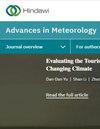Air Temperature Modeling Based on Land Surface Factors by the Cubist Method (Case Study of Hamoun International Wetland)
IF 2.1
4区 地球科学
Q3 METEOROLOGY & ATMOSPHERIC SCIENCES
引用次数: 0
Abstract
The drying up of Hamoun International Wetland (HIW) and the loss of vegetation in this area have led to an increase in ambient temperature. This research examines the changes in the surface of HIW and its role in air temperature (Tair) using data on land surface temperature (LST), vegetation, wind speed, and relative humidity. The Cubist regression model (CRM) is used to simulate the effects of land surface factors (LSFs) on Tair. Four microsites with different plant cover percentages were selected for this purpose. After data collection, 75% of the data were used for modeling and 25% of the data were used for model testing. The results showed that CRM has adequate performance for estimating Tair. The assessment of the relationship between land surface temperature (LST) and Tair at 2 meter height showed that there was a high correlation coefficient between 0.86 and 0.91 in the different microsites. The results of using CRM for estimating Tair showed that this model can estimate air temperature from independent parameters of LST, wind speed, vegetation percentage, and relative humidity with a correlation coefficient of 0.98. In this model, the LST, relative humidity, and vegetation percentage were entered with values of 100%, 93%, and 83% respectively. Wind speed was not included in the model because the measurements were constant and less than 4 m/s throughout the period (no changes).基于立方体方法地表因素的气温建模(哈蒙国际湿地案例研究)
哈蒙国际湿地(HIW)的干涸和植被的减少导致了环境温度的升高。本研究利用地表温度 (LST)、植被、风速和相对湿度数据,研究了哈蒙国际湿地表面的变化及其对气温 (Tair) 的作用。采用立体回归模型(CRM)模拟地表因子(LSF)对气温的影响。为此选择了四个不同植物覆盖率的微观站点。数据收集后,75% 的数据用于建模,25% 的数据用于模型测试。结果表明,CRM 在估算 Tair 方面具有足够的性能。对 2 米高处的地表温度(LST)与 Tair 之间关系的评估表明,不同微观站点的相关系数在 0.86 至 0.91 之间。使用 CRM 估算 Tair 的结果表明,该模型可根据独立参数 LST、风速、植被百分比和相对湿度估算气温,相关系数为 0.98。在该模型中,低温层、相对湿度和植被率的输入值分别为 100%、93% 和 83%。风速未被纳入模型,因为测量值在整个期间都是恒定的,且小于 4 米/秒(无变化)。
本文章由计算机程序翻译,如有差异,请以英文原文为准。
求助全文
约1分钟内获得全文
求助全文
来源期刊

Advances in Meteorology
地学天文-气象与大气科学
CiteScore
5.30
自引率
3.40%
发文量
80
审稿时长
>12 weeks
期刊介绍:
Advances in Meteorology is a peer-reviewed, Open Access journal that publishes original research articles as well as review articles in all areas of meteorology and climatology. Topics covered include, but are not limited to, forecasting techniques and applications, meteorological modeling, data analysis, atmospheric chemistry and physics, climate change, satellite meteorology, marine meteorology, and forest meteorology.
 求助内容:
求助内容: 应助结果提醒方式:
应助结果提醒方式:


